[ENG/ESP] Ruddy Daggerwing butterfly in my garden! (Marpesia petreus) 🦋/ ¡Una mariposa Ala de Daga Rojiza en mi jardín! (Marpesia petreus) 🦋
Have a nice day, nature lovers!
¡Ten un lindo día, amante de la naturaleza!

Recently I had a pleasant surprise in my garden, an unusual visitor. A beautiful and eye-catching butterfly that fluttered for the first time over the Lantana flowers.
Recientemente tuve una grata sorpresa en mi jardín, una visitante inusual. Una hermosa y llamativa mariposa que por primera vez revoloteaba sobre las flores de la Lantana.
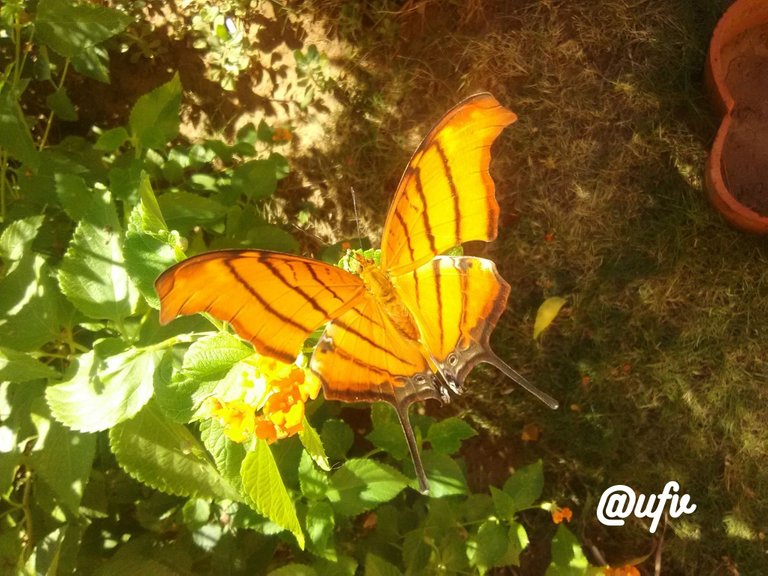
I love learning about these cute insects of captivating and ever-changing beauty, so while the butterfly was feeding I captured some images with my cell phone camera and when it left, I immediately searched for information about it on the internet.
With the help of Google Images and some time, I found some interesting pages that talked about my unusual visitor.
Its scientific name is Marpesia petreus and it is known as the Rubby Daggerwing Butterfly because of the small dagger-like canes on its lower wings.
Me encanta aprender sobre estos lindos insectos de belleza cautivadora y siempre cambiante, así que mientras la mariposa se alimentaba capturé algunas imágenes con la cámara de mi celular y cuando se fue inmediatamente busqué información sobre ella en internet.
Con la ayuda de Google Imágenes y algo de tiempo encontré algunas páginas interesantes que hablaban sobre mi inusual visitante.
Su nombre científico es Marpesia petreus y se le conoce como Mariposa Ala de Daga Rojiza por los pequeños bastoncillos con forma de daga que tienen en sus alas inferiores.

It is a butterfly that lives in areas of Central America, North America, the Caribbean and the West Indies as far south as Florida.
Its wings are of intense orange color, decorated with three black lines that combine very well and that in the males are more showy than in the females.
Es una mariposa que vive en áreas de América Central, América del Norte, el Caribe y las Antillas hasta el sur de Florida.
Sus alas son de color naranja intenso, decoradas con tres líneas negras que combinan muy bien y que en los machos son más vistosas que en las hembras.
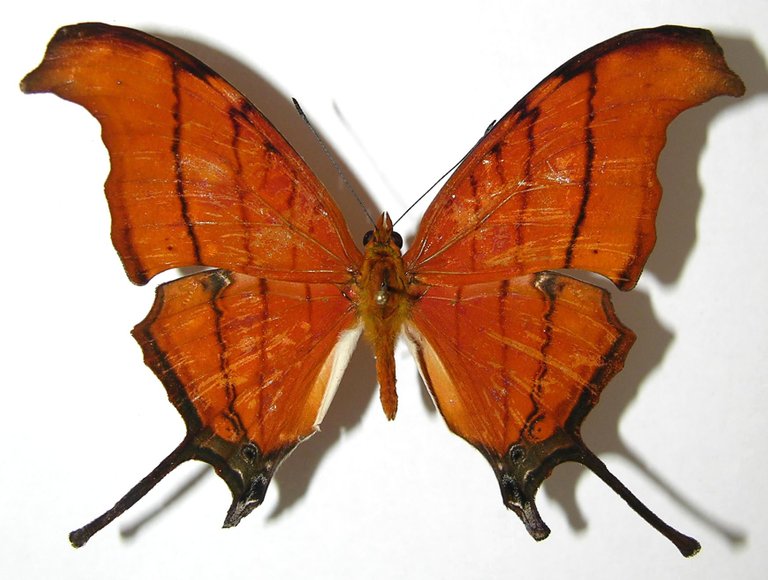
(Área de Conservación Guanacaste)
License Creative Commons Atribución/Reconocimiento 4.0
Licencia Pública Internacional (CC BY 4.0)
If you compare the photograph of the female Marpesia petreus with the one I took in my garden, we can easily affirm that my pretty visitor was a male of this species.
They have a wingspan of 7 to 9.5 cm (2 ¾ - 3 ¾ inches) and the most striking thing about them, as I already mentioned, are the dagger-like canes on the underside.
Si se compara la fotografía de la hembra de Marpesia petreus con la que tomé en mi jardín, fácilmente podemos afirmar que mi linda visitante era un macho de esta especie.
Tienen una envergadura de 7 a 9,5 cm (2 ¾ - 3 ¾ pulgadas) y lo más llamativo en ellas, como ya les mencioné, son los bastoncillos en forma de dagas que tienen en la parte inferior.
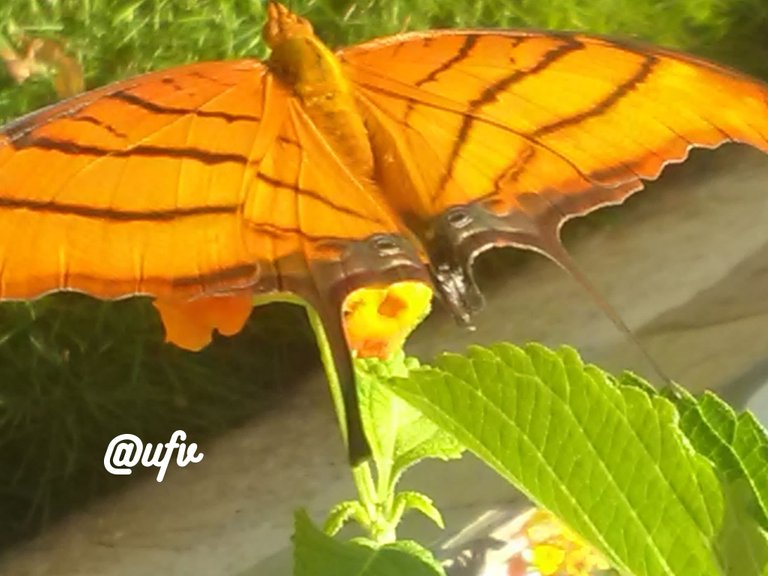
When at rest with its wings closed, it could be seen that these to be mottled brown and black with a dull hue that resembled a dried tree leaf.
Cuando estaba en reposo con las alas cerradas, se podía ver que estas estaban moteadas de marrón y negro con un tono opaco que se asemejaba a una hoja de árbol seca.

Those who study these butterflies have observed that their eggs are white and they are deposited solitarily on common fig and wild fig plants (Ficus carica and F. citrifolia).
The larva of this species is very different from those I have seen so far. It is brown and black with white figures on the back, similar to triangles. The design of its spots allows it to go unnoticed by predators. On the back of its body it has stingers.
Quienes estudian estas mariposas han observado que sus huevos son de color blanco y son depositados en solitario sobre higueras comunes e higueras silvestres (Ficus carica y F. citrifolia).
La larva de esta especie es muy diferente a las que he visto hasta ahora. Es de color marrón y negro con figuras blancas en el dorso, similares a triángulos. El diseño de sus manchas le permite pasar desapercibido para los depredadores. En la parte posterior de su cuerpo tiene aguijones.
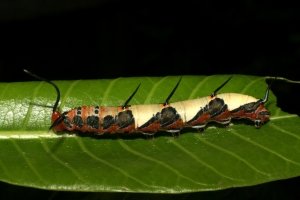
License Creative Commons Atribución/Reconocimiento 4.0
Licencia Pública Internacional (CC BY 4.0)
The Marpesia petreus butterfly in its adult stage feeds on the nectar of Lantana, Giant milkweed, Cordia, Casearia and Mikania.
La mariposa Marpesia petreus en su etapa adulta se alimenta del néctar de Lantana, Algodoncillo gigante, Cordia, Casearia y Mikania.
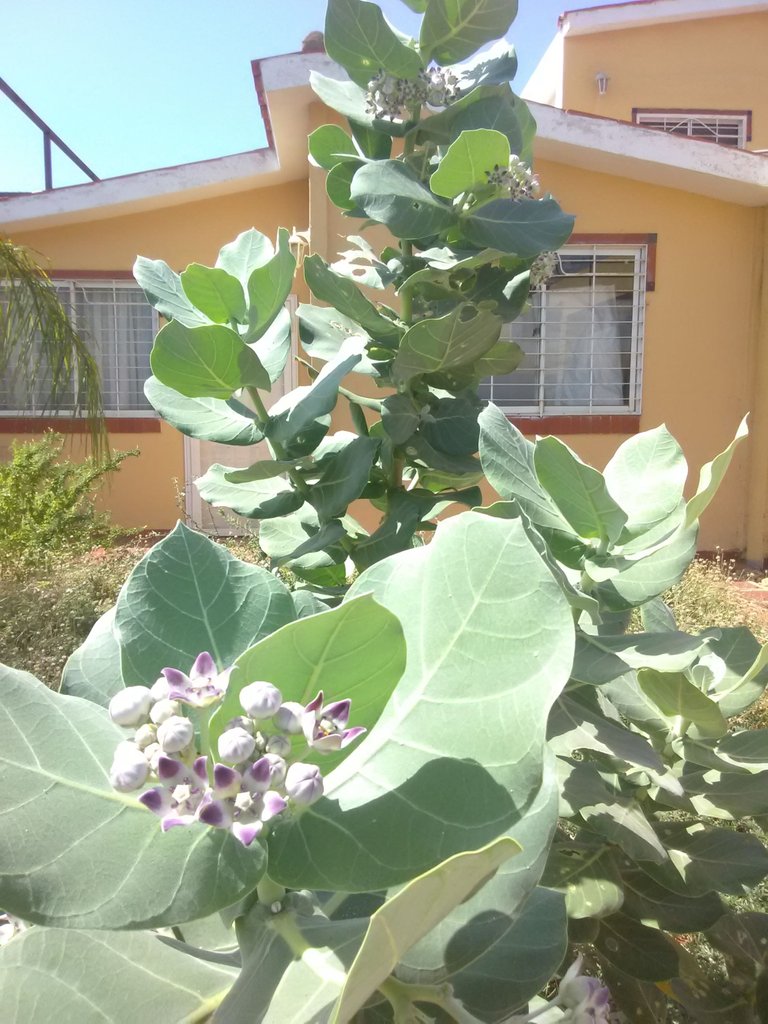
In the months of May to July they are seen more than in other months and to reproduce the males perch in sunlit trees to observe the females.
En los meses de mayo a julio se les ve más que en otros meses y para reproducirse los machos se posan en árboles soleados para observar a las hembras.
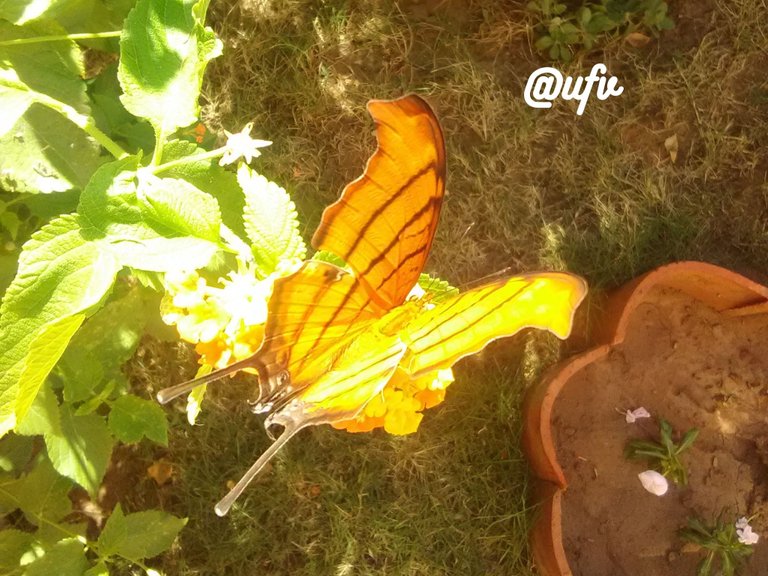
When the larva reaches its maximum growth, it begins to build a silk to form the chrysalis. This process takes about 5 to 6 weeks.
The chrysalis of Marpesia petreus is white with black spots and thin spines on the trunk and head, as can be seen in the following image:
Cuando la larva alcanza su máximo crecimiento, comienza a construir una seda para formar la crisálida. Este proceso toma alrededor de 5 a 6 semanas.
La crisálida de Marpesia petreus es blanca con manchas negras y finas espinas en el tronco y la cabeza, como se puede apreciar en la siguiente imagen:
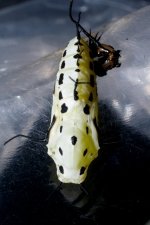
License Creative Commons Atribución/Reconocimiento 4.0
Licencia Pública Internacional (CC BY 4.0)
At this stage there is a risk that the chrysalis or pupa (as it is also known) may be parasitized by flies or attacked by predators such as ants or bees.
In the giant milkweed plant that I showed you in the previous paragraphs, there was a Monarch´s chrysalis that was eaten by some other insect and could not become a beautiful butterfly.
En esta etapa existe el riesgo de que la crisálida o pupa (como también se le conoce) pueda ser parasitada por moscas o atacada por depredadores como hormigas o abejas.
En la planta de Algodoncillo gigante que les mostré en los parrafos anteriores, había una crisálida de Monarca que fue devorada por algún otro insecto y que no pudo llegar a convertirse en una hermosa mariposa.
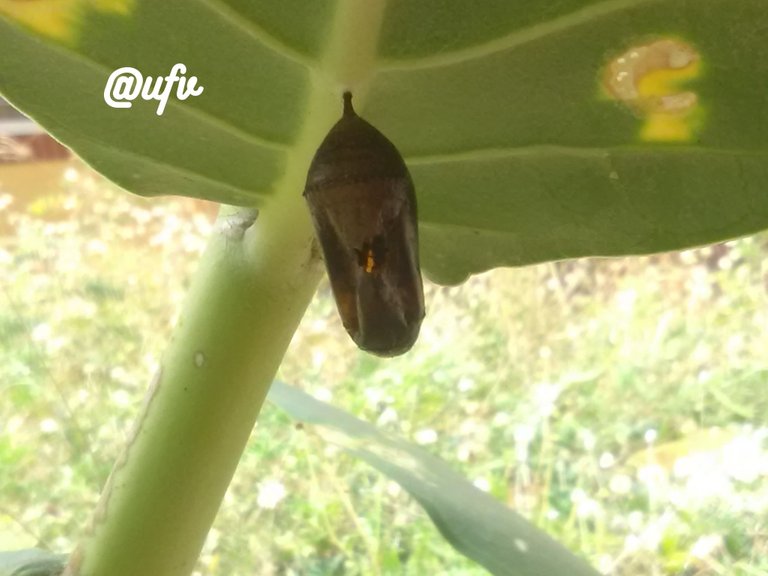
This is what I learned about this beautiful butterfly. I hope the content was easy to understand and pleasant to read.
I look forward to seeing you next time.
Esto es lo que aprendí sobre esta hermosa mariposa. Espero que el contenido haya sido fácil de entender y agradable de leer.
Espero verte la próxima vez.
References / Referencias
- https://www.butterfliesandmoths.org/species/Marpesia-petreus
- https://en.wikipedia.org/wiki/Marpesia_petreus
- https://es.frwiki.wiki/wiki/Marpesia_petreus
- https://colombia.inaturalist.org/taxa/50283-Marpesia-petreus
- https://www.acguanacaste.ac.cr/paginas-de-especies/insectos/104-nymphalidae/681-i-marpesia-petreus-i-nymphalidae
0
0
0.000
@tipu curate :)
Upvoted 👌 (Mana: 0/81) Liquid rewards.
Congratulations @ufv! You have completed the following achievement on the Hive blockchain and have been rewarded with new badge(s):
Your next target is to reach 7000 upvotes.
You can view your badges on your board and compare yourself to others in the Ranking
If you no longer want to receive notifications, reply to this comment with the word
STOPCheck out the last post from @hivebuzz:
Support the HiveBuzz project. Vote for our proposal!